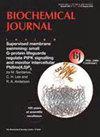Identification of inhibitors of human ChaC1, a cytoplasmic glutathione degrading enzyme through high throughput screens in yeast.
IF 4.3
3区 生物学
Q2 BIOCHEMISTRY & MOLECULAR BIOLOGY
引用次数: 0
Abstract
The cytosolic glutathione-degrading enzyme, ChaC1, is highly up-regulated in several cancers, with the up-regulation correlating to poor prognosis. The ability to inhibit ChaC1 is therefore important in different pathophysiological situations, but is challenging owing to the high substrate Km of the enzyme. As no inhibitors of ChaC1 are known, in this study we have focussed on this goal. We have initially taken a computational approach where a systemic structure-based virtual screening was performed. However, none of the predicted hits proved to be effective inhibitors. Synthetic substrate analogs were also not inhibitory. As both these approaches targeted the active site, we shifted to developing two high-throughput, robust, yeast-based assays that were active site independent. A small molecule compound library was screened using an automated liquid handling system using these screens. The hits were further analyzed using in vitro assays. Among them, juglone, a naturally occurring naphthoquinone, completely inhibited ChaC1 activity with an IC50 of 8.7 µM. It was also effective against the ChaC2 enzyme. Kinetic studies indicated that the inhibition was not competitive with the substrate. Juglone is known to form adducts with glutathione and is also known to selectively inhibit enzymes by covalently binding to active site cysteine residues. However, juglone continued to inhibit a cysteine-free ChaC1 variant, indicating that it was acting through a novel mechanism. We evaluated different inhibitory mechanisms, and also analogues of juglone, and found plumbagin effective as an inhibitor. These compounds are the first inhibitor leads against the ChaC enzymes using a robust yeast screen.通过酵母中的高通量筛选鉴定人ChaC1(一种细胞质谷胱甘肽降解酶)的抑制剂。
细胞膜谷胱甘肽降解酶 ChaC1 在多种癌症中高度上调,上调与预后不良相关。因此,在不同的病理生理情况下,抑制 ChaC1 的能力非常重要,但由于该酶的底物 Km 很高,因此具有挑战性。由于目前还没有已知的 ChaC1 抑制剂,在这项研究中,我们将重点放在了这一目标上。我们最初采用了一种计算方法,进行了基于系统结构的虚拟筛选。然而,没有一个预测的结果被证明是有效的抑制剂。合成的底物类似物也没有抑制作用。由于这两种方法都针对活性位点,我们转而开发了两种独立于活性位点的高通量、稳健、基于酵母的检测方法。利用这些筛选方法,我们使用自动液体处理系统筛选了一个小分子化合物库。对筛选出的化合物进一步进行了体外分析。其中,juglone(一种天然萘醌)完全抑制了 ChaC1 的活性,IC50 为 8.7 µM。它对 ChaC2 酶也有效。动力学研究表明,这种抑制作用与底物之间不存在竞争关系。众所周知,丁螺环酮可与谷胱甘肽形成加合物,还可通过与活性位点半胱氨酸残基共价结合而选择性地抑制酶。然而,丁螺环酮仍能抑制不含半胱氨酸的 ChaC1 变体,这表明它是通过一种新的机制发挥作用的。我们评估了不同的抑制机制以及朱格隆的类似物,发现plumbagin是一种有效的抑制剂。这些化合物是利用强大的酵母筛选技术找到的首个针对 ChaC 酶的抑制剂线索。
本文章由计算机程序翻译,如有差异,请以英文原文为准。
求助全文
约1分钟内获得全文
求助全文
来源期刊

Biochemical Journal
生物-生化与分子生物学
CiteScore
8.00
自引率
0.00%
发文量
255
审稿时长
1 months
期刊介绍:
Exploring the molecular mechanisms that underpin key biological processes, the Biochemical Journal is a leading bioscience journal publishing high-impact scientific research papers and reviews on the latest advances and new mechanistic concepts in the fields of biochemistry, cellular biosciences and molecular biology.
The Journal and its Editorial Board are committed to publishing work that provides a significant advance to current understanding or mechanistic insights; studies that go beyond observational work using in vitro and/or in vivo approaches are welcomed.
Painless publishing:
All papers undergo a rigorous peer review process; however, the Editorial Board is committed to ensuring that, if revisions are recommended, extra experiments not necessary to the paper will not be asked for.
Areas covered in the journal include:
Cell biology
Chemical biology
Energy processes
Gene expression and regulation
Mechanisms of disease
Metabolism
Molecular structure and function
Plant biology
Signalling
 求助内容:
求助内容: 应助结果提醒方式:
应助结果提醒方式:


